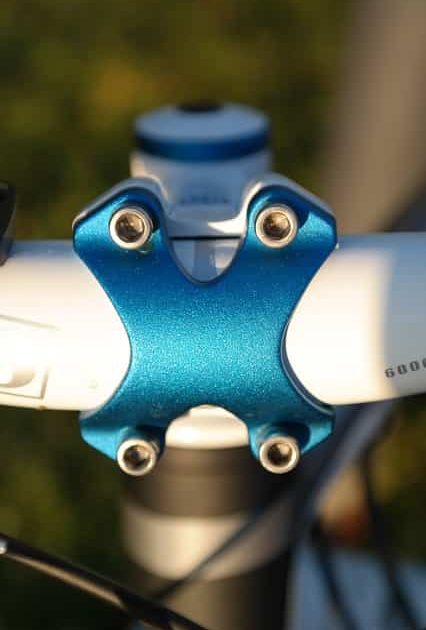Worrying if your stem length is right for your mountain biking needs? Well you can learn in this post how stem length affects your handling, steps to measure it properly and optimize handling.
The stem’s primary objective in a mountain bike is to clamp the handlebars to the steer tube. The stems are available in various length & rise options and manufactured out of various materials using different processes.
Using a longer stem puts the rider in better control of the bike when riding on steep climbs.
On the flip side, a shorter stem ensures quick handling and a more responsive feel.
In this article, we’ll cover how does stem affect bike handling? How to measure the stem length? How to pick the right stem? We’ll also put forth top stem recommendations based on customer reviews and ratings.
So, Let’s Scroll Down and Find Out:-
- Does Stem length Affect Bike Handling?
- How To Measure Stem length on MTB
- Relationship: Stem, Handlebars, and Handling
- How Does a Shorter Stem Affect Bike Handling?
- When is the stem Too Short?
- How Does Stem Angle Affect Your Ride?
- How To Pick The Right MTB Stem
- Our Favorite Mountain Bike Stems
- So What Does All It Means?
Does Stem length Affect Bike Handling?
The one-word to your query is yes; the MTB stem’s length directly impacts bike handling. A shorter stem of a mountain bike is like a car’s power steering, while a longer stem is more like a boat’s tiller.
By using a shorter stem, you’ll have better and quick control of your bike, but a stem shorter in length is more susceptible to even the slightest movement of your body, which in turn translates into twitchiness.
If you opt for a lengthy stem having a short top tube, the bike handling will be slow. To better understand, if the rider’s hand is far ahead of the steering axis, it would be challenging to steer the mountain at low speeds.
Many women tend to go with a shorter stem because it suits their short torsos.
Finally, you’ve to self decide on the mountain bike stem’s length to have the best drive performance and experience.


How To Measure Stem length on MTB
The stem’s length defines how much wrist you can bend forward and how far you reach to grab the handlebars.
If you decide on the right stem length, your hands, head, neck, and back will be in a more comfortable position, along with the even distribution of the weight. So, correctly measure the stem length for replacement or decide what length of stem you require on your new mountain bike.
First of all, look at your mountain bike’s headset; it rests on the steering head and holds the steering column. To measure your mountain bike’s stem, you’ve to do it from the headset’s center to the handlebars’ center.
You need to translate the measurement of your mountain bike stem into millimeters.
For instance, the length of your mountain bike stem comes out to be 7 inches, so to convert inches into millimeters, you’ve to multiply it by 25.4.
Relationship: Stem, Handlebars, and Handling
There is a direct relation between mountain bike’s stem and handlebars, which eventually greatly impact the bike’s handling.
Ideally, the stem length cannot be too short or too long. The longer the mountain bike’s stem is, the more the rider will be leaning forward and a firmer grip over the handlebars.
Consequently, the mountain bike will be more stable, especially when running at high speeds, thus the big reason why the professional riders opt for a longer stem and a shorter frame.
The extra stability is even more crucial during windy conditions.
On the other hand, a shorter stem will have quick steering. Ideally, the stem must be long enough to place some of the biker’s weight on the front wheel for improved road grip and steering. Simultaneously, the stem should provide an adequate steering arch that complements your bike’s trial and head angle.
The handlebars operate in conjunction with the stem to dictate where the biker’s hands will end up and your body & weight positioning.
Riders who opt for a considerably shorter stem will significantly benefit from increasing the handlebar’s width.
How Does a Shorter Stem Affect Bike Handling?
The shorter stem length of the mountain affects the bike’s overall performance. One of the most compelling reasons bikers are a big fan of the shorter stem is its ability to boost the bike’s handling capabilities.
The shorter stem delivers a more responsive feel than a lengthy mountain bike stem. The longer stem provides better pedal position when riding on steep mountains.
The handlebar’s reach also affected the stem’s length. Here, the reach is the distance from the head tube center and vertical line imaginary drawn across the bracket’s button.
So, if you feel you’ve to stretch too much to hold the handlebars, then it’s time; you’ve to stem length. Otherwise, you’ll develop shoulder, back, and neck pain over time if you take frequent bike tours.
The stem raise is also a crucial factor in smooth bike handling; the handlebars are relative to the mountain bike’s stem. Most of the stems have a rise of between zero and six degrees.
The zero degrees means the stem is not raising the handlebars, whereas the 6 degrees raises the handlebars much higher than the bike’s stem.
When is the stem Too Short?
If you have an aggressive style of biking, you need to go for a shorter length mountain bike stem as then you’ll have superb control like riding a car, take sharp turns, and have good control at high speeds.
There is no rule of thumb when deciding the stem’s length; it depends mainly upon the biker’s perspective. Failing to pick the correct stem length would lead to lower back and neck pain when riding the bike.
For aggressive trail biking, the recommended stem length is in the range of 50mm-60mm.
A shorter length stem enables better control by making the relationship between the bilker and the steering more detectable, as the hands have a comfortable rotation around the steering axis, similar to your car’s steering wheel, rather than a narrowboat tiller that swings out & around.
Thus, ensuring the biker has a smooth ride on the ragged edges & slides.
How Does Stem Angle Affect Your Ride?
The stem raise also affects the biking experience; it refers to how the mountain’s handlebars are placed relative to the stem. The stem raise is measured in degrees.
You have to think of the stem rise as an imaginary line vertically drawn from the bottom of the handlebar to the stem’s bottom. The most prevalent stem raise measures are 0 and 6 degrees.
The zero degrees mean that the handlebars haven’t raised handlebars, whereas the 6 degrees mean the handlebars are raised relative to the bike’s stem.
If you want a much lower position, go with a negative stem raise that lowers the bike’s handlebars in relation to the ground. On the other hand, if you wish for a more upright position, then consider a positive stem raise to lend you a comfortable fit.
So, the whole idea is finalizing the stem raise according to your personal preference.
How To Pick The Right MTB Stem
Here, we’ll enlist the key factors to mull over when buying a mountain bike stem:-
The Stem Length
Changing your mountain bike stem’s length impacts your comfort and fit and the road handling dynamics.
A shorter stem will provide snappier steering, while a lengthy stem will make the steering slower.
Adjusting the mountain bike’s stem length can be tailored according to the handling. Professional riders use a shorter stem, and a long-distance cyclist prefers a longer stem.
The Correct Reach
The reach is another factor to consider when deciding on the mountain bike stem. The reach is the imaginary vertical measurement, drawn through the bottom of the bracket to the center head tube. All the bikes come with reach and stack measurements, aiming to increase sales.
A longer mountain bike stem doesn’t change this reach, but it does alter the effective bike reach, and it’s worth consideration. If you’ve been riding your bike for quite some time and happy with the overall fit, then it is a good indication that the stem on your bike is fine, and you don’t need to replace it.
Or, if you feel cramped, pain in the shoulders, neck, or lower back, there is a clear indication that you can redo your bike’s stem.
Optimum Position
If you’re aiming for a position that has a slight bend in the elbows, allowing your arms to bend easily as the front wheel tracks the surface of the road.
If your arm is locked out straight, then it is a clear sign that your stem is too long.
Stem Angle
Another thing to keep in mind when buying a mountain bike stem is the stem rise. For a long position, a stem with a negative rise stem is ideal. A positive stem rise provides a more upright position for a comfortable fit.
Our Favorite Mountain Bike Stems

1. Renthal Apex Bike Stem
Made out of premium-quality Aluminium, the Renthal Apex Bike Stem enables a more aggressive riding position. It is lighter and more comprehensive than the standard stems.
The Renthal Apex Bike Stem can be mounted both ways to reduce or add the angle. The stem has a length range of 40mm-90mm.
The Apex stem installation is not complicated; it hardly takes a few minutes if you carefully follow all the instructions. It outperforms other stems as it delivers a better feel, more control, and less vibration.
According to most consumer feedback, this stem held the bars effectively; there were no issues with regards to loose bolts. This bike system’s side is artistic, rendering a stroke of pure class and elegance to the overall appeal of the mountain bike.
The Renthal Apex Bike Stem is well-machined; there is no roughness, no sharp edges, and pretty smooth.
Pros
- Lightweight
- The handlebar clamps are well designed.
Cons
- Slightly on the expensive side.

2. RaceFace Chester Stem
The RaceFace Chester Stem is highly durable, unmatched tough, and features bold graphics for biking lovers. This system eliminates the stress risers, which causes your Bar to bend/break.
The Interlocking U Shaped Handlebar Clamp Geometry enables the smooth transfer of load from the stem body rather than the bolts.
It comes with four-bolt clamps to secure the Bar in position, even on rugged roads. It is extremely durable & fatigue resistant; therefore, it is termed an all-mountain stem.
The RaceFace Chester Stem is a practical product with two length options, stylish graphics, and legendary bomb-proof Race Face toughness.
It is made from forged & blasted 2014 alloy to provide the high strength you deserve. Why think or rethink; you can order online at the best price in the market.
Pros
- Smart clamp design
- Sturdy and durable design
Cons
- Slightly heavier compared to other stems.

3. Truvativ Holzfeller Black MTB Stem
Truvativ Holzfeller Black MTB Stem is light in weight without compromising its overall quality and durability. The stem is 50mm in length and has a 0-degree rise. The 31.8 clamp diameter provides an ideal fit. While its strong construction presents you with the confidence to ride on trails.
It features a central alignment mark, which is present on the edge of the faceplate’s cut for ensuring the Bar is positioned accurately.
It is easy to set-up; you can do it all by yourself, no professional help is needed to mount it onto your bike.
The shape & design of the Truvativ Holzfeller Black MTB Stem looks impressive, strong but not bulky at the same time. The stem Fits 1-1/8″ steerer tubes. You can order online for the Truvativ Holzfeller Black MTB Stem at a relatively lower price.
Pros
- Fairly light compared to stock.
- Simple yet classy design
Cons
- None that I find

4. RaceFace Respond Mountain Bike Stem
The RaceFace Respond Mountain Bike Stem is made from forged & blasted 6061 aluminum for great strength & fatigue, with reasonable weight.
The four-bolt clamp holds the Bar securely in position. It is best suited for bikers who wish for unparalleled performance on all trails. This stem is engineered to present an optimal combination of stiffness, weight, and strength at an attractive price.
The RaceFace Respond Mountain Bike Stem feels super-sturdy and ready to tackle just about any road. The discreet torque settings on the stem are the biggest USP of this stem.
Another plus point of opting for this stem is that it is easy to set up, you don’t need to spend hours reading the complicated guidelines and then implementing them, a few simple instructions, and the job is done.
Pros
- The nice solid stem at a reasonable cost.
Cons
- Design is not its strongest suit.

5. Ritchey Comp 4-Axis Stem
Last but the least is Ritchey Comp 4-Axis Stem. Weighted 150kg and 30-degree stem angle, this stem is for those who wish for a smooth ride every day, every tour.
It is a reliable and conveniently adjustable system that outperforms its market rivals. This stem is an entry-level product that is suitable for kinds of bikers.
The Ritchey Comp 4-Axis Stem looks great on every bike, comes in standard & oversize clamp sizes, which is its pro point. It is light in weight and comes with shims for various steerer tubes.
It is highly recommended for anyone in search of a superlight non-carbon stem.
Pros
- Super dependable & straightforward.
- Easy to adjust
Cons
- None that I can think of.
So What Does All It Means?
So, we explained a lot about the stem, how its length affects riding, and how to choose the perfect stem length. Before you opt for any of our recommendations, make sure you know your expectations and talk to your biker friend for advice. Now, the ball is in your court.
You have to take the final call on the most appropriate stem length and choose the product accordingly.
Also Read,
Are Bar Ends Worth It? How And Why To Install Bar Ends On MTB
Do Mountain Bikes Holds Their Value? MTB Depreciation Guide









Leave a Reply